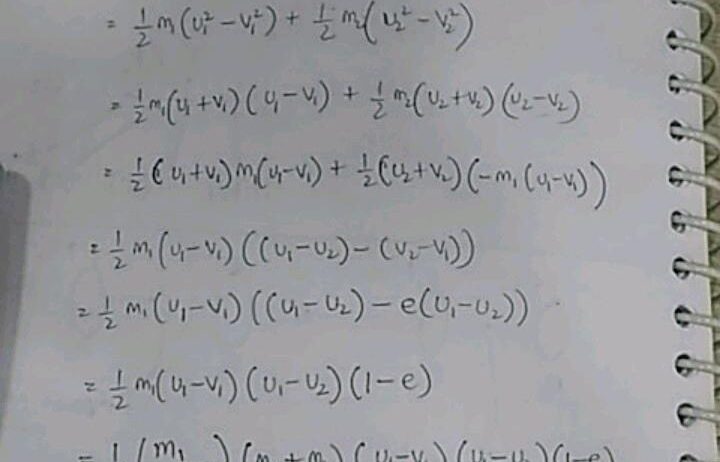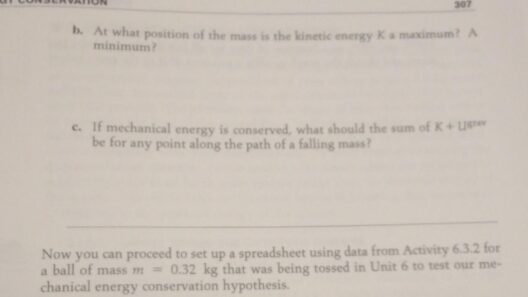Understanding the principles of kinetic energy and how it behaves under various conditions is pivotal in the realms of physics and engineering. One fundamental question arises in the context of collisions: Is kinetic energy conserved in an inelastic collision? This query invites an exploration of the intricate dance between energy forms and the physical realities that govern motion.
To answer this question—let’s first define what an inelastic collision entails. In classical mechanics, an inelastic collision occurs when two objects collide and stick together, moving as one mass post-impact. This scenario starkly contrasts with elastic collisions, where kinetic energy is conserved. Yet, what happens to the seemingly ‘lost’ kinetic energy in an inelastic collision?
Dissecting this phenomenon requires an understanding of energy transformation. In an inelastic collision, while the total momentum of the system is conserved, the kinetic energy undergoes a metamorphosis into other forms of energy—primarily thermal energy and sound. This transformation might feel counterintuitive at first glance, especially when kinetic energy, which is associated with motion, seems to vanish. However, the principles governing these transformations illustrate a fascinating aspect of energy dynamics.
As we venture into this discussion, we delve deeper into the concept of energy conservation—a cornerstone of physical science that often invites intriguing dialogue.
Exploration of Energy Conservation Principles
Energy conservation is a fundamental concept that asserts energy cannot be created or destroyed but merely transformed from one form to another. In the context of collisions, it becomes essential to break down the ideas of momentum and kinetic energy conservation.
Momentum, represented by the product of mass and velocity, is conserved in all collision types—both elastic and inelastic. This conservation reflects the principle of isolation; as long as no external forces act upon the colliding bodies, the overall momentum remains unchanged.
Kinetic energy, however, adheres to a different narrative within inelastic collisions. The energetic dialogue shifts when these bodies collide and some initial kinetic energy is absorbed by the objects themselves, producing permanent deformation or generating heat and sound. Thus, throughout this collision, the kinetic energy is not lost but redirected into alternate domains as the particles engage and intermingle. This reveals a critical aspect of energy dynamics: it’s the transformation, not annihilation, of energy we should focus on.
Pathways of Energy Transformation During Inelastic Collisions
Examining inelastic collisions offers a wealth of insights into how energy transitions between states. Let’s elucidate the common forms into which kinetic energy might be diverted during such collisions.
Heat Energy:
In an inelastic collision, a significant portion of kinetic energy is converted into thermal energy, warming the colliding bodies and their surroundings. Such temperature increases can manifest in various ways, leading to different material behaviors upon impact. The heat produced often leads to microstructural alterations within materials, affecting their integrity and future performance.
Sound Energy:
The auditory feedback we experience during collisions is another clear indicator of energy transformation. The impact generates sound waves, dispersing kinetic energy through the air as acoustic energy. This sound realization serves as a reminder of the dynamic changes occurring in the collision process, reinforcing the inextricable link between motion and the sensory experiences accompanying it.
Deformation and Internal Energy:
Inelastic collisions often result in permanent deformation. The materials compress, bend, or break, absorbing kinetic energy in the form of internal energy. This energy stays within the object, fundamentally altering its structure and potentially affecting its mechanical properties. Observing this phenomenon reveals the fascinating interplay between motion and material integrity, where energy conversion has real-world implications.
Accepting Reality: Energy Loss in Context
While it may be tempting to regard the transformation of kinetic energy into other forms as ‘loss’, a more profound understanding reveals that this lost energy plays a critical role in a system’s functionality. This perspective shift invites one to ponder energy questions not merely in terms of what is ‘lost’ but rather what is ‘transformed’ and ‘utilized’. Recognizing that energy is perpetually in flux allows for deeper insights into the mechanics of systems, from vehicles to the natural environment.
The broader implications of inelastic collisions extend beyond theoretical physics. They reverberate through engineering design, safety protocols in automobile manufacturing, and even environmental considerations in wildlife conservation. The lessons drawn from kinetic energy transformations during inelastic collisions can inform practices that enhance safety, performance, and sustainability.
Concluding Perspectives on Kinetic Energy and Collisions
In closing, the intriguing reality surrounding kinetic energy during inelastic collisions emphasizes an essential aspect of physics—energy is not merely maintained or lost but continually transformed in ways that shape both our understanding and our world. By recognizing this duality of kinetic energy and momentum conservation, we are empowered to consider broader implications across various domains, inviting curiosity and promoting innovative thinking about how we interact with energy in our daily lives.
In essence, is kinetic energy conserved in an inelastic collision? The answer reframes itself from a simple yes or no into a dynamic exploration of energy transitions, providing a richer understanding of our physical environment. Embracing this perspective can inspire solutions that harness the continuous cycles of energy, encouraging us to evolve and adapt in harmonious symbiosis with our surroundings.








